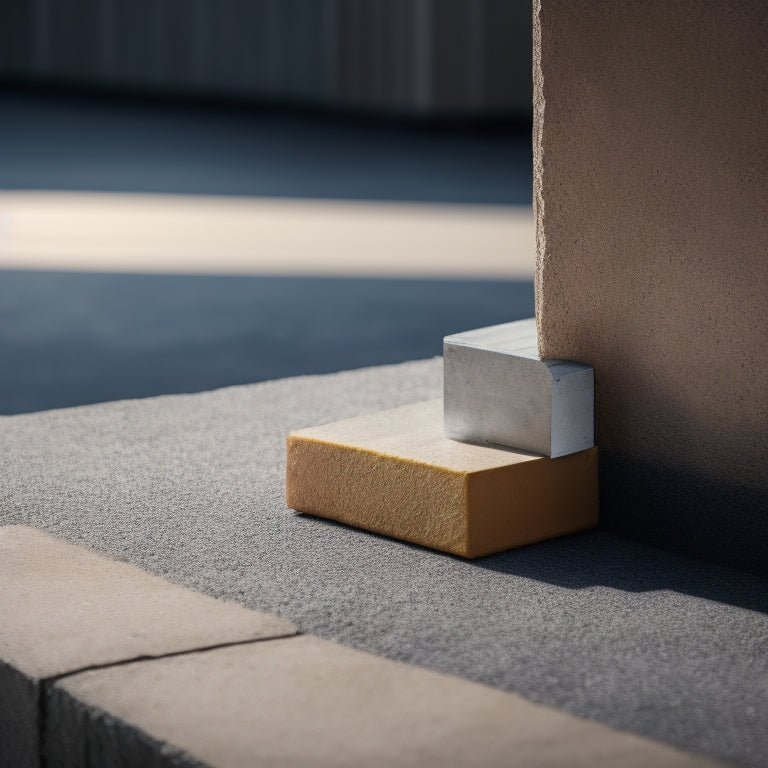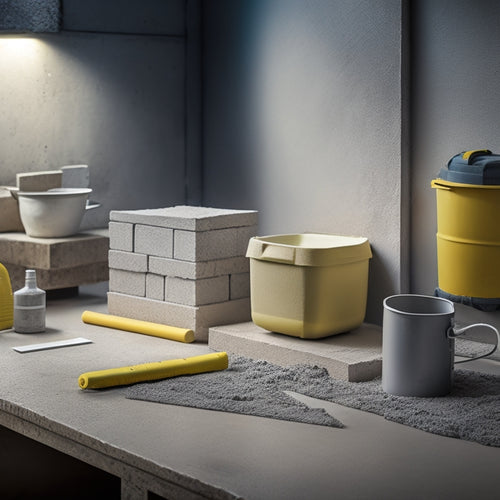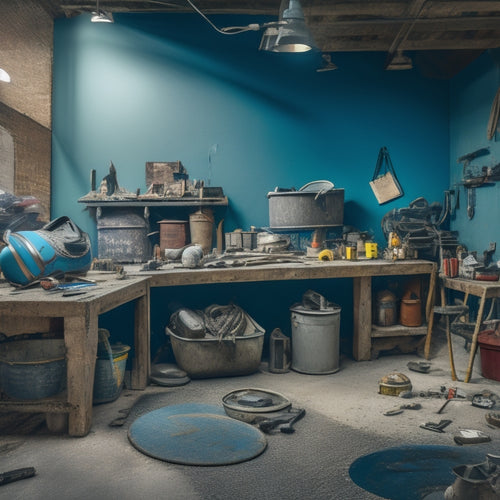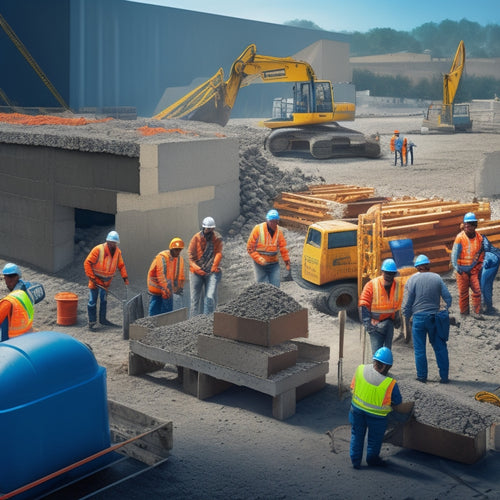
Top 3 Must-Have Tools for Laying Concrete Blocks
Share
You'll need a level to guarantee accurate block alignment and horizontal placement, a trowel to apply and smooth mortar for a clean finish, and a jointer to create uniform joints for a professional appearance. These three tools are essential for a successful concrete block project, as they directly impact the quality and durability of your finished work. By using these must-have tools, you'll be well on your way to achieving a structurally sound and visually appealing outcome. As you begin your project, you'll want to explore how to effectively utilize these tools to ensure a successful result.
Key Takeaways
• A level is essential for ensuring accurate block alignment and horizontal placement to achieve structural soundness and visual appeal.
• A trowel is a must-have for applying and smoothing mortar for a clean finish and strong bond between blocks.
• A jointer is critical for creating uniform joints that add to the professional appearance of the finished structure.
• Safety gear, including gloves, safety glasses, and a dust mask, is vital for protecting oneself from injury and harm.
• A spirit level, laser level, or string line is necessary for ensuring precise leveling and alignment of blocks to avoid costly mistakes.
Essential Block Laying Equipment
You'll need a level, a trowel, and a jointer to confirm accurate block alignment, smooth mortar application, and professional-looking joints. These fundamental tools will help you attain a sturdy and visually appealing concrete block structure.
When selecting block types, consider the specific requirements of your project, such as load-bearing capacity, texture, and color. It's crucial to choose blocks that meet the necessary standards for your construction project.
Remember to prioritize safety gear, including gloves, safety glasses, and a dust mask, to protect yourself from potential hazards. A trowel will come in handy for applying and smoothing mortar, while a jointer will help you achieve uniform joints.
Depending on the scope of your project, you may also require additional equipment, such as a mixer or a saw. Always follow the manufacturer's instructions and guidelines for each tool to guarantee ideal results.
Leveling and Alignment Tools
Accurate leveling and alignment of concrete blocks rely on a trio of essential tools: a spirit level, a laser level, and a string line. You'll use these tools to guarantee your blocks are perfectly horizontal and vertically aligned, which is critical for a structurally sound and visually appealing wall.
A spirit level is a classic tool that's still effective for checking individual blocks, but it's limited in its ability to provide a broader view of the wall's alignment.
That's where laser levels come in – these tools project a level line or dot across the entire surface, allowing you to quickly identify any deviations from the desired plane.
For more complex layouts, a string line is an indispensable alignment guide. By stretching a taut string between two points, you can create a precise reference line that helps you position blocks accurately.
With these three tools in your arsenal, you'll be able to achieve professional-grade results and avoid costly mistakes.
Mortar Mixing and Finishing
Mixing mortar to the right consistency and finishing it smoothly are essential steps in laying concrete blocks, as they directly impact the structural integrity and aesthetic appeal of the final product.
You must achieve a consistent mortar mix that's not too runny or too thick, as this will affect the bond between the blocks and the overall structure. To get it right, you'll need to follow the manufacturer's instructions and use the correct ratio of cement to sand to water.
When it comes to finishing, you'll need to master various trowel techniques to achieve a smooth, even surface.
Hold your trowel at a 45-degree angle and use a gentle, sweeping motion to spread the mortar evenly. Use a level to guarantee the surface is straight and a spirit level to check for plumb.
Finish the surface with a float or trowel, applying gentle pressure to remove excess mortar and create a smooth finish. Remember, practice makes perfect, so don't be discouraged if it takes a few attempts to get it right.
With the right tools and techniques, you'll be laying concrete blocks like a pro in no time.
Frequently Asked Questions
Can I Lay Concrete Blocks in Cold Weather Conditions?
When you're planning to lay concrete blocks in cold weather, you'll need to take extra precautions to guarantee a strong, durable structure.
You'll want to prioritize cold weather precautions, such as using accelerators or insulating concrete blocks to maintain a consistent temperature. This will help prevent damage from freezing temperatures and guarantee a successful project.
How Do I Clean My Tools After Laying Concrete Blocks?
Your tools are caked with concrete, resembling a fossilized relic of a bygone era. Don't let them become a permanent fixture - take action!
Cleaning your tools after laying concrete blocks is essential for tool maintenance. Use a wire brush to scrub off excess concrete, then soak them in a mixture of water and mild detergent.
Next, dry and lubricate moving parts to prevent rust. By doing so, you'll guarantee your tools remain in top condition, ready to tackle the next project with unbridled power.
Do I Need to Wear Protective Gear When Laying Blocks?
When laying concrete blocks, you'll be working with heavy, rough materials and dealing with flying debris.
You'd better take safety precautions seriously! Wear protective equipment like sturdy gloves, safety glasses, and a dust mask to shield yourself from harm.
Don't risk injury - cover your skin with long sleeves and pants, and consider a hard hat and steel-toed boots for added protection.
Can I Use a Hammer Drill for Mixing Mortar?
You're probably thinking, 'Why can't I just use a hammer drill for mixing mortar?'
But trust us, you'll end up with a subpar mix that'll compromise your blockwork's integrity.
For efficient mortar mixing, you need a mixer specifically designed for that task.
A hammer drill's high-speed rotation will only introduce air pockets and weaken the mortar.
Instead, invest in a dedicated mortar mixer to guarantee a smooth, consistent blend that'll make your concrete blocks sit pretty.
How Long Does It Take for Mortar to Fully Set?
When you're working with mortar, you need to know how long it'll take to fully set. Mortar curing times vary depending on environmental factors like temperature, humidity, and air circulation.
Typically, it takes around 24 to 48 hours for mortar to reach its initial set, but it can take up to 28 days to fully cure. You'll know it's fully set when it's hardened and resistant to scratches.
Keep an eye on these factors to guarantee your mortar sets properly and your concrete blocks are secure.
Conclusion
You've laid the foundation, literally! Now, as you put the final block in place, remember that having the right tools is like having a trusty sidekick - it's the difference between a medieval castle and a modern marvel.
Don't get stuck in the dark ages, invest in these top 3 must-haves and your concrete block masterpiece will be the envy of the town.
With these tools, you'll be building like a pro in no time, and your structure will stand the test of time, just like the Pyramids of Giza!
Related Posts
-

What Tools Do I Need for Concrete Block Laying
You'll need a thorough set of tools to guarantee accurate, efficient, and professional concrete block laying. Essenti...
-

What Tools Do You Need for Concrete Flooring
You'll need a thorough arsenal of specialized tools to achieve a high-quality, professional-looking concrete floor, i...
-

7 Best Tools for Concrete Block Construction
You'll need a solid foundation, precise cutting, and seamless finishing to guarantee your concrete block construction...


